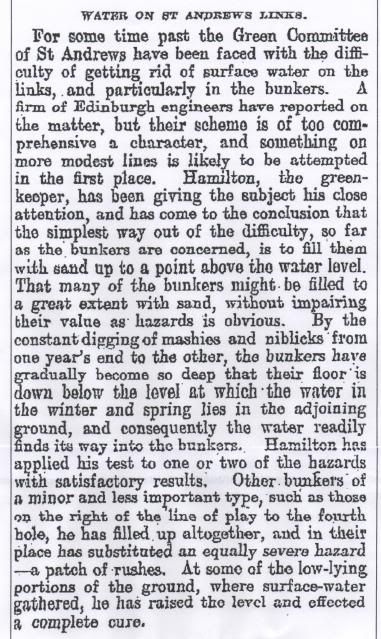Old Courses are spotted by many bunkers some in line of play, some protecting Greens and some on the peripheral. Yet perhaps unseen by many there are generally quite a few old filled in discarded bunkers. Due to no fault of their own or for that matter the original designer we find them totally removed from not only play but sight, leaving a shallower version of the pot marked lunar surface.
There are probably many good reasons for their demise, the main being down to technology and the improvement in the ball and its flight characteristics. Nevertheless there are other reasons why old bunkers are no longer there in full working glory. Many partly or completely filled in, left to fade into the surrounding land from which they originally came. I feel I should also offer a blessing and thanks for the past work they did before reading that time honoured statement “Ashes To Ashes, Dust To Dust”. I joke of courses, but let’s not forget that they were located there for a purpose, we may no longer remember why but that is not to say that they did not do the job their designer intended.
There are other reason for the disappearance of bunkers, one I though may be interest to this site as it refers to TOC. The information came from an article inThe Scotsman Newspaper dated 10th May 1910 but those who have read Scott Macpherson’s book ‘The Evolution of The Old Course’ will notice that he touched upon the problem.

This takes me onto the subject of worms which many here feel have no influence on the state of a golf course, well excluding their casts that is. I wonder because the R&A under Hamilton’s guidance started to eliminate the worms from circa 1904. Old Tom over the years cultivated the worms (even producing a special rake for their casts on the Greens) and it was noted that the course would not suffer from pooling after major down pours plus the turf was well maintained and aerated giving quality mixed with better longevity.
My understanding regards TOC was that in the early day Old Tom also suffered from bunkers filling up a foot to 15” and his remedy was raising the height of the floor making the bunker shallower and sometimes with a top mound to counter the lost depth. The only other major water problem was from the Eden Estuary and its attack on a double bunker. At one stage after a couple of storms the Green was nearly washed away, well the Eden came up to the edge of the Green.. Yet by the late 1880’s the problem had resolved itself and the Green was safe, today the estuary is set back even further.
I still wonder if the modern Green Keepers are right to minimise the worms as I feel they do far more that general fertilisers, but of course there is a little more involvement in utilising Nature way that modern methods eliminate. As for the worms, I feel they have a place, but more work needs to be done to prove they are a good friend to the Keep of the Greens.
Melvyn